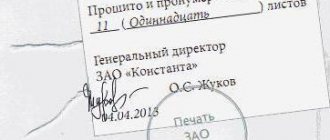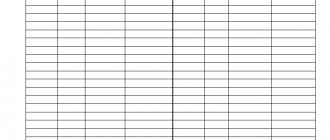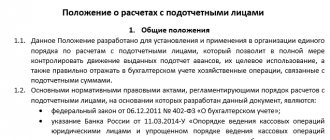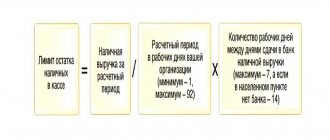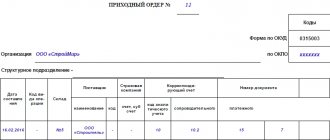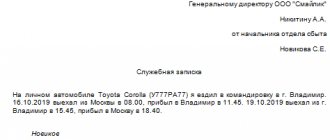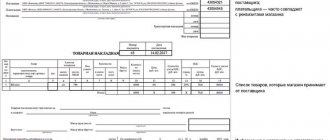Cash documents when working with cash
All cash transactions must be documented with primary cash documents. Documentation of cash transactions is strictly regulated. Let's list the basic rules.
Despite the fact that since 2013, most unified forms have ceased to be mandatory, cash documents are drawn up strictly on forms approved by Resolution of the State Statistics Committee of the Russian Federation dated August 18, 1998 N 88. For the issuance of wages and scholarships, forms approved by the Resolution of the State Statistics Committee of the Russian Federation dated January 5, 2004 are used. N 1.
Cash documents are prepared and signed by authorized persons:
- cashier;
- senior cashier (appointed if the organization has several cashiers);
- Chief Accountant;
- supervisor.
The cashier is provided with sample signatures of authorized persons and a seal (stamp) with details confirming the cash transaction.
If the manager or individual entrepreneur runs the cash register personally, he alone signs the cash documents. Sample signatures are not provided.
Cash documents can be issued:
- on standardized forms, handwritten with handwritten signatures of the participants in the operation;
- on printed forms in paper form with handwritten signatures of the participants in the operation;
- in electronic form using a program to protect against unauthorized access and an electronic signature in accordance with Federal Law dated 04/06/2011 N 63-FZ.
Corrections in cash documents, neither in paper nor in electronic form, are allowed (clause 4.7 of the Directive of the Central Bank of the Russian Federation N 3210-U).
Setting up a cash register
It is better to configure the equipment in stages. It is convenient to configure cash register equipment in such a way as to combine items similar to each other in one category. For example, one category of goods is taxed with a certain value, while for another there are no taxes at all (this also happens). Next you need to set the correct date and time values.
The device programming mode starts when the key is turned to the PROG (P) position. If there is a button on the case, then you need to go to the Program menu item and in this mode set the desired configuration. Many device models are equipped with a special lever located under the cover of the paper roll compartment. This element is also switched to Program mode. You need to set up the cash register only according to the job description of the cashier-operator of the online cash register.
Cash documents for receipt and withdrawal of funds
Receipt cash order (KO-1)
Each receipt of funds at the cash desk is formalized by a Receipt Cash Order (PKO) (Form N KO-1, approved by Resolution of the State Statistics Committee of the Russian Federation dated August 18, 1998 N 88). When registering the receipt of money at the cash desk, the cashier must (clause 5 of Directive of the Central Bank of the Russian Federation N 3210-U):
- check the signature of an authorized person (accountant, chief accountant, manager) on the PQR with the sample;
- count the money in the presence of the depositor, check that the accepted amount corresponds to that indicated in the PQS;
- check the availability of supporting documents specified in the PQS;
- if everything matches, sign the document, sign and put a seal (stamp) on the tear-off receipt, hand it over to the bearer.
In 1C, the printed form KO-1 is generated from the Cash Receipt . PDF
Expense cash order (KO-2)
Each fact of withdrawal of funds from the cash register is documented with a Cash Expenditure Order (RKO) (Form No. KO-2, approved by Resolution of the State Statistics Committee of the Russian Federation dated August 18, 1998 N 88). When registering the withdrawal of money from the organization’s cash desk, the cashier must (clause 6 of Directive of the Central Bank of the Russian Federation N 3210-U):
- check the signature of authorized persons (accountant, chief accountant, manager) on the cash register with the sample;
- check the availability of supporting documents specified in the RKO;
- identify the person accepting the funds using an identification document;
- prepare the amount for transfer, transfer the cash register to the receiving person for signature;
- recalculate funds in front of the recipient;
- sign RKO.
In 1C, the printed form KO-1 is generated from the Cash Issue . PDF
If funds are accepted (expended) on the basis of fiscal documents provided for in paragraph. 27 art. 1.1 of Federal Law N 54-FZ, then receipts (expenses) can be issued with one PKO (RKO) upon completion of cash transactions.
Rules for working with the organization's cash register
As a rule, the cashier must operate the cash register.
It is with him that the head of the organization enters into an agreement on full financial responsibility. If there is no such employee on staff, both an accountant and the head of the organization can be appointed to his position. Every year, a legal entity must agree with the bank on the limit on the cash balance in the cash register at the end of the working day. That is, cash should be kept in the cash register only in the amount indicated in the calculation. You can pick up this form from your financial institution, complete it, and submit it before the new calendar year. If you do not do this, you do not have the right to store funds in the organization’s cash register.
Cash documents when issuing salaries, scholarships
When issuing wages, scholarships and other payments to employees, together with KO-2 the following can be issued (approved by Resolution of the State Statistics Committee of the Russian Federation dated January 5, 2004 N 1):
- payroll T-49;
- payroll T-53.
Statements are forms for group payments of funds. The total amount for these statements is formed from the amounts for each individual person. The deadline for issuing cash for payments is determined by the manager and is indicated in both forms. The specified period cannot exceed 5 working days, including the day of receipt of money from the bank account (clause 6.5 of the Directive of the Bank of the Russian Federation dated March 11, 2014 N 3210-U).
The procedure for issuing funds according to statements is similar to the procedure for issuing cash according to cash settlement services and is accompanied by affixing the recipient’s signature next to his name in the statement.
Payroll T-49
Payroll T-49 is intended for the calculation and payment of wages, scholarships and other accruals to the recipient (or group of recipients). The total amount on the statement is formed from the amounts for each individual person. The period for issuing cash for payments is determined by the manager and is indicated in the payroll statement T-49, but cannot be more than 5 working days, including the day the money is received from the bank account (clause 6.5 of the Bank of the Russian Federation Directive dated March 11, 2014 N 3210 -U).
If form T-49 is filled out and used for settlements with recipients, then statement T-53 (payroll) is not used.
In 1C, the printed form T-49 is generated from the document Statement to the Cashier . PDF
Payroll T-53
Payroll T-53 is intended for the payment of wages, stipends and other payments to the recipient (or group of recipients). In the tabular part, it contains only the amount to be paid for each recipient.
In 1C, the printed form T-53 is generated from the document Statement to the Cashier . PDF
On the need for a cashier-operator journal
The cashier-operator's journal (ZhKO) is a document in which the entrepreneur indicates income, expenses and daily revenue. In addition, the following are included in the housing and communal services:
- cash register counters at the beginning and end of the shift;
- the amount of revenue received per shift;
- signatures of responsible persons;
- amounts of funds that were deposited in cash and non-cash forms;
- total revenue;
- amount of funds for returned goods.
If an entrepreneur or organization uses an online cash register for payments, housing and communal services are not required. At the moment, it needs to be filled out only by those who have not switched to KKM under the deferment until 2021 or are completely exempt from it.
54-FZ abolished the registration of a number of accounting documents that previously had to be maintained. Now all data that was entered into acts, journals and reference reports manually is taken into account by the cash register automatically.
Cash books
Cash book KO-4
All facts of income and expenditure of funds are recorded in the cash book (form KO-4, approved by Resolution of the State Statistics Committee of the Russian Federation dated August 18, 1998 N 88). Records are kept for each incoming and each outgoing cash order. The book must ensure full posting of cash to the cash desk in compliance with the following rules (clause 4.6 of Bank of Russia Directive No. 3210-U dated March 11, 2014):
- The cash book is kept by the cashier. At the end of the working day, he checks the amount of cash in the cash register with the data of cash documents and the balance indicated in the cash book. If the data matches, he certifies the entries in the cash book with a signature.
- Control over the maintenance of the cash book is exercised by the chief accountant, and in his absence, by the head of the organization.
- Separate divisions transfer copies of sheets of the KO-4 cash book to the head division in the manner and within the time limits established by the organization, taking into account the timing of its preparation of accounting (financial) statements.
If an organization operates as a paying agent (subagent), then when accepting money within the framework of this activity, PKO and RKO, it enters KO-4 in a separate cash book (clause 4.6 of Bank of Russia Directive No. 3210-U dated March 11, 2014).
In 1C, the printed form KO-4 is generated from the Bank and cash desk section – Cash desk – Cash documents – Cash book button. PDF
Book of accounting of funds accepted and issued by the cashier KO-5
If an organization transfers funds between cashiers and a senior cashier during the working day, then the senior cashier makes entries in the KO-5 book of accounting for cash received and issued by the cashier.
This document is not generated in 1C. The form can be downloaded here Excel To access the section, log in to the site.
See also:
- The procedure for conducting cash transactions
- The procedure for accounting for monetary documents
Did the article help?
Get another secret bonus and full access to the BukhExpert8 help system for 14 days free of charge
Related publications
- Procedure for conducting cash transactions: legislation If an organization conducts cash payments, it must be equipped…
- How can I set up cash documents so that they can be signed by authorized persons? ...
- Why can't I print cash documents? ...
- The procedure for cash payments has been updated The Bank of Russia has introduced new rules for cash payments (Instruction dated 12/09/2019...
Receipt of funds at the cash desk
Money can come to the cash desk from various sources, for example, from the organization’s current account, from counterparties, from founders, from accountable persons, etc. In any case, you must document the receipt of money; to do this, use a cash receipt order (form No. KO-1). The document must be drawn up in a single copy. You must give the detachable part, signed by the cashier and the chief accountant, to the person who deposited the money.
The cash receipt order is filed with the cashier's report and registered in the cash document registration book (Form No. KO-3).
In accounting you must make the following entries:
— D50 K51 – funds were received at the cash desk from the organization’s current account;
— D50 K62 – funds were received at the cash desk from counterparties;
— D50 K71 – funds were received at the cash desk from the accountable person;
— D50 K75 – funds were received at the cash desk from the founder
— D50 K90.1 – funds were received at the cash desk as a result of the sale.
How to work as a cashier with an online cash register in difficult situations
This could include situations such as:
- Power outage.
If the cash register operates without a battery (and it is not possible to use an uninterruptible power supply), then it obviously cannot be used for the purpose of fiscalizing the amounts accepted from customers. In this case, trade will have to be suspended, since accepting funds from buyers without subsequent fiscalization of the accepted amount is an administrative violation and leads to large fines.
However, if there is reliable information that the electricity has been turned off for a long time, and customers really need goods from the store (for example, if these are essential food products), then, as a last resort, you can try to release them without punching receipts - by issuing documents to customers, replacing checks (for example, these can be sales receipts or strict reporting forms). But later you must:
- break through revenue using familiar correction checks;
- notify the Federal Tax Service of the forced non-use of online cash registers due to a long power outage (with a certificate or other document from Energosbyt attached stating that there was a power failure).
However, this method of “legalizing” sales when the online cash register is disabled only reduces (albeit significantly) the likelihood of a fine, but does not reduce it to zero. It all depends on the position of the specific tax office. It is possible that the store owner will have to prove his case in court.
- Internet shutdown.
This is the most minor problem. The online cash register can fully function without a constant Internet connection. The main thing is to ensure the transfer of fiscal data to the OFD at least once every 30 days . But if you don’t do this, the fiscal drive will be blocked if you fail to fulfill this obligation. Therefore, if a malfunction in the Internet is detected, it would be a good idea for the cashier to inform management or the employees responsible for the network about this.
- Failure of cash register equipment (for example, it has a software glitch, it is damaged, something was spilled on it, etc.).
A cash register that refuses to work obviously cannot be used. Its non-use, although forced, constitutes the same administrative violation as the failure to use the cash register during a power outage. Therefore, in general, there is only one recommendation - stop trading.
But there are also non-standard situations. For example, a massive technical failure in the operation of a cash register from a certain manufacturer, as happened on December 17, 2017. Here again, however, sellers have a cost-effective way of responding to the situation—essentially similar to the one discussed above in the blackout scenario. You can continue trading without punching checks (optionally, issuing BSO or sales receipts to customers to confirm the purchase), and then:
- fiscalize accepted amounts using correction checks;
- if there has been a massive technical failure in the operation of a cash register from a certain manufacturer, request from such cash register manufacturer documentation confirming the occurrence of a massive failure in the cash register equipment (and certifying the fact that the store is not at fault);
- send to the Federal Tax Service all available information on the situation that has arisen.
Video - report on a massive technical failure in the operation of online cash registers on December 17, 2017:
But this method is applicable if the cash register refused to work for reasons beyond the direct control of the retailer. If the CCP fails because something was spilled or dropped on it, the scheme we considered most likely will not work.
A special case is the failure of the cash register due to force majeure.
- Force Majeure.
Scenarios with a power outage, a breakdown of cash register equipment, and, possibly, a long-term Internet outage due to the destructive effects of natural or man-made factors, are possible here. The cash register can be washed away by a rain wave, or some heavy object can fall on it during a strong gust of wind.
In this case, trade must be stopped by law, but no one in their right mind would think about this. The store must be ready to immediately supply those in need with essential goods - with or without receipts. And the Federal Tax Service, most likely, will not even try to demand any clarification from the business entity regarding the non-use of online cash registers.
If you do not know how to register a cash register with the tax office, step-by-step instructions will help you understand the algorithm for this procedure.
We advise you to read the article about the nuances of using cash register equipment by individual entrepreneurs in different taxation systems.
What innovations were used in terms of calculation, registration and payment of UTII.
Video - how to use the EKR 2102K-F online cash register:
